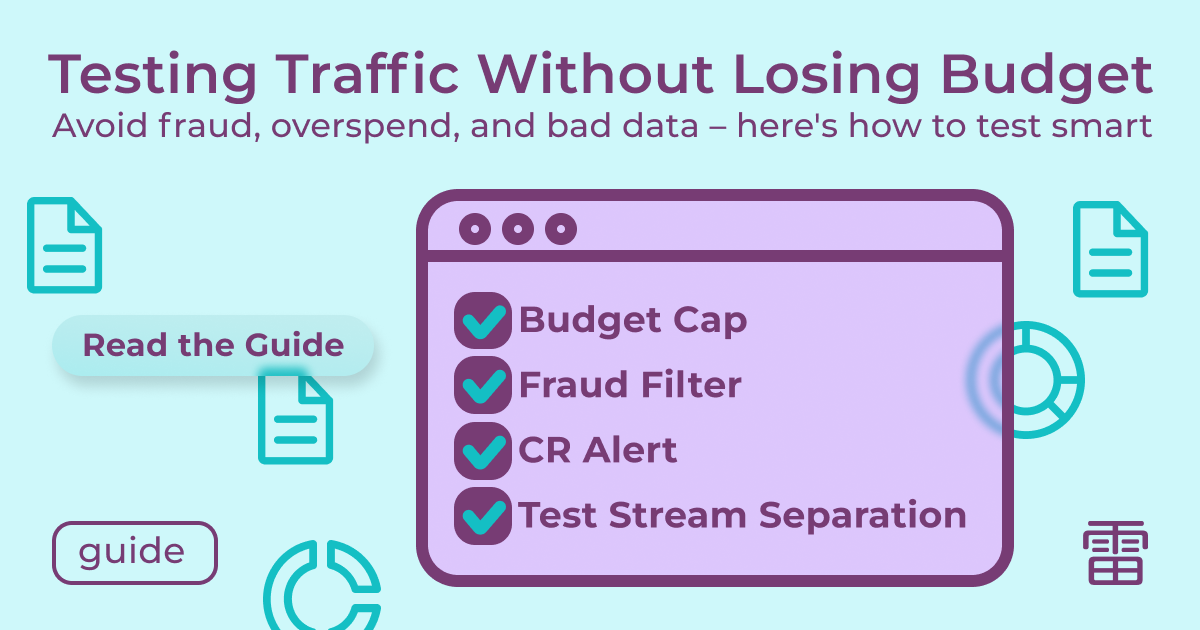Launching a new traffic source always holds promise for growth—but also comes with financial risk. Even if the partner looks reliable and the offer is familiar, one wrong test setup can drain thousands in a matter of days.
Want a step-by-step traffic testing checklist tailored to your ad stack? Book a demo call—we’ll show you how to build a control-first process from day one.
Why Most Traffic Tests Fail
Affiliate traffic has become more unpredictable and technically advanced. Many networks only connect trackers, analytics, or fraud filters after launch — and by then, it’s often too late.
Top reasons why traffic tests fail:
- No clear definition of success (what is “good” traffic?)
- Incomplete analytics (no breakdown by segment, landing page, or device)
- No source separation (traffic is mixed and hard to isolate)
- Weak fraud defense on entry
- Premature decisions made on small sample sizes
What a Safe Test Looks Like
1. Set a clear volume baseline
Define minimum traffic for statistical relevance. Example:
– 1,000 clicks + 50 leads
– 3 full days of activity
2. Hard budget cap
Set a clear spend limit per source. Once it's reached — stop automatically.
3. Separate tracking flow
Each new source should run on its own sub-ID or tracking stream. This allows you to:
– Pause independently
– Compare with other traffic
– Build clean, segmentable reports
Want to test new traffic without data chaos? Book a demo — we’ll show you how to set up a controlled flow in 15 minutes.
What to Monitor During the Test
Your tracker shouldn’t just collect leads. A test must surface deeper signals:
Performance metrics:
– CR (conversion rate)
– Hold/reject rate
– Session behavior: time on page, interaction flow
– Device/user agent/IP consistency
Warning signs:
– Spikes in CR from low volumes
– Duplicate IPs or fingerprints
– Instant conversions (3 seconds post-click?)
– Even click flow in off-hours
All of this can be automated with dashboards and smart alerts.
Fraud Detection Must Come First
Waiting until the advertiser flags fraud is too late. Every test should begin with built-in validation.
At Kaminari Click, we protect your test budget with:
– Ping-stage filtering: geo, IP, device, browser
– Session fingerprinting
– Internal fraud logic scoring every lead
– Conversion & CR limits per traffic stream
A scalable source isn’t the one that brings leads—it’s the one that brings clean leads.
Common Mistakes to Avoid
1. Testing in the main stream
Without separation, it’s impossible to isolate impact or stop quickly.
2. Judging only by CR
High CR may indicate fraud, not efficiency.
3. No access to logs
Without logs, you can’t audit traffic or defend rejections.
4. Dragging out tests
If 1,000 clicks offer no clarity—don’t continue blindly.
What Safe Testing Looks Like with Kaminari Click
– Every source is run in a separate tracking stream
– Anti-fraud rules enabled by default
– Budget and CR thresholds defined up front
– Leads go through structured funnel (lead > hold > approved/rejected)
– Full real-time dashboards
– Alerts notify you of CR or anomaly spikes
On average, ad networks run a traffic test in 3–5 days with full clarity and no overspend.
Conclusion
Safe traffic testing isn’t about “wait and see.” It’s about clear metrics, isolated flow, built-in validation, and structured decision-making.
In 2025, the most successful networks aren’t the ones with the most sources—they’re the ones that filter fast.
Kaminari Click lets you test, validate, and scale sources—with full transparency.
Book a demo call—we’ll show you how to test smart, stay safe, and grow without guesswork.

